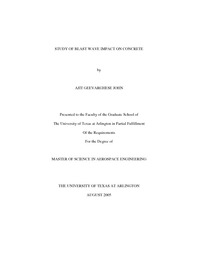
ATTENTION: The works hosted here are being migrated to a new repository that will consolidate resources, improve discoverability, and better show UTA's research impact on the global community. We will update authors as the migration progresses. Please see MavMatrix for more information.
Show simple item record
| dc.contributor.author | John, Ajit Geevarghese | en_US |
| dc.date.accessioned | 2007-08-23T01:56:35Z | |
| dc.date.available | 2007-08-23T01:56:35Z | |
| dc.date.issued | 2007-08-23T01:56:35Z | |
| dc.date.submitted | July 2005 | en_US |
| dc.identifier.other | DISS-1013 | en_US |
| dc.identifier.uri | http://hdl.handle.net/10106/383 | |
| dc.description.abstract | The past decade has brought an upsurge of terrorist attacks throughout the world. A common form of attack is bombings employed against a civilian structure. These bombs lead to blast waves resulting from high explosive bursts in air, causing severe structural damage to buildings that often collapse before evacuation is possible. These blast waves subject the buildings to repeated dynamic loading in the form of reflecting shock waves which then finally lead to their destruction. Many studies have been carried out to understand the static loading of these structures. The current study is to protect existing buildings from an explosion. The proposal is to use a weak sand-cement mixture to form an outer boundary wall to absorb the impact of an explosion outside its boundary and protect the civilian structure.
A blast wave front possesses characteristics similar to a shock wave created in a shock tube and a reasonably realistic simulation of blast loading on structures can be made using an equivalent shock simulator. Such a shock simulator is safe, has high productivity and provides reproducible results. The set up is discussed in detail in this thesis.
While shock waves are different from blast waves in possessing a different profile, shock wave impacts still provide a reasonable simulation of the blast wave during an explosion. This is because the damage is caused by the impacting pressure. Smith and Hetherington (1994) discuss wave front parameters and scaling laws that can be used to simulate the effect of a charge of TNT at a certain distance from the target. These scaling laws can be used to compare the total pressure of the shock wave impact calculated based on the shock speed. Four strain gauges are mounted on a concrete cylinder specimen to detect the strength and time of the shock wave as it passes through the cylinder.
Studies show that the concrete mixture used can withstand shock wave impact at lower blast strengths (lower Mach numbers). At higher Mach numbers, the cylinder breaks off as a result of the stronger reflecting shock wave. A study of the wave propagation and attenuation trends in the cylinders is done in the thesis. There is also a comparison between the shock wave and blast wave strengths based on wave front and scaling parameters. | en_US |
| dc.description.sponsorship | Lu, Frank | en_US |
| dc.language.iso | EN | en_US |
| dc.publisher | Aerospace Engineering | en_US |
| dc.title | Study Of Blast Wave Impact On Concrete | en_US |
| dc.type | M.S. | en_US |
| dc.contributor.committeeChair | Lu, Frank | en_US |
| dc.degree.department | Aerospace Engineering | en_US |
| dc.degree.discipline | Aerospace Engineering | en_US |
| dc.degree.grantor | University of Texas at Arlington | en_US |
| dc.degree.level | masters | en_US |
| dc.degree.name | M.S. | en_US |
| dc.identifier.externalLink | https://www.uta.edu/ra/real/editprofile.php?onlyview=1&pid=274 | |
| dc.identifier.externalLinkDescription | Link to Research Profiles | |
Files in this item
- Name:
- umi-uta-1013.pdf
- Size:
- 4.795Mb
- Format:
- PDF
This item appears in the following Collection(s)
Show simple item record


